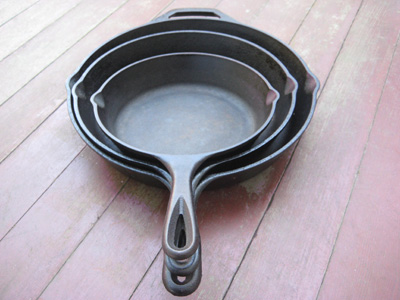• They radiate heat beautifully, so your food doesn't cook unevenly.
• You can go from stovetop to the oven, so there' s never a need to transfer food to a baking dish after sautéing.
• Once your pans are seasoned, they have a natural non-stick surface so you don't have to breath in that awful chemical-smelling aroma that is emitted when you overheat a Teflon pan.
• They retain heat well, making them perfect for both frying and simmering.
• They may be the least expensive pans available, costing around $20 for a 10-inch version and around $30 for the extra large size.
• They last forever (my friend Pam uses her grandmother's pan, which was purchased at least 90 years ago).
• Your food picks up a little bit of iron when using a cast iron pan, so they're a great way to supplement your diet.
If you randomly look through my posts on Bay Area Bites, you'll see my cast iron pans used over and over. This is because I use them for almost everything. Certain dishes that I only make in my handy dandy cast iron pans are:
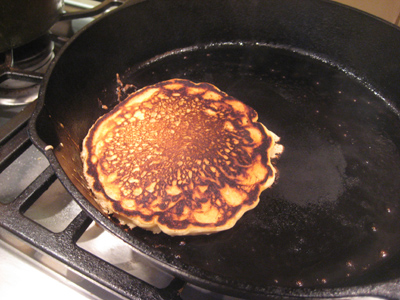
• Seared meat -- This includes meat for stews, steaks, and some fish. Cast iron's ability to evenly radiate and distribute heat makes it the perfect tool for searing.
• Casseroles -- Cast iron pans are great for mixing up casserole ingredients on the stove and then transferring the entire dish to the oven to bake further.
• Pancakes -- To make decent pancakes, you really need to start with a hot and evenly heated pan. Plus cast iron also gives you a perfectly flat surface for making those flapjacks.
• Eggs -- I bought a smaller cast iron pan specifically for breakfast. As anyone who has made eggs using an aluminum pan knows, they have a tendency to stick to the surface of the pan, which is messy and frustrating to clean. But the natural non-stick surface of a seasoned cast iron pan lets you avoid all that. From scrambled to sunny side up, cast iron cooks my eggs perfectly every time and requires very little clean up.
• Fried chicken or beer-battered fish -- Once again, even heat distribution combined with the ability to maintain a consistent temperature makes cast iron perfect for these dishes.
• Cornbread and biscuits -- My 10-inch cast iron pan has always cooked these items so they are slightly crisp on the outside and fluffy on the inside -- just the way I like them.
• Vegetables -- I cook most of my vegetables in a cast iron pan. From sautéing zucchini and broccoli on the stove top to roasting cauliflower, Brussells sprouts and root vegetables in the oven, my pans cook vegetables beautifully.
• Tart Tatin -- A cast iron pan is the perfect vehicle for caramelizing those apples in butter and sugar, adding the dish to the oven when it's ready to be baked, and then flipping onto a dish (using its ergonomic handle) when you're ready to serve.
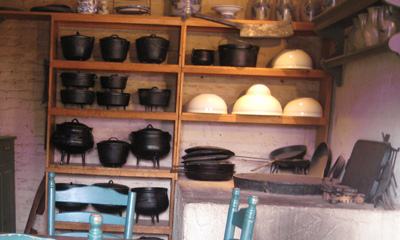
Why do you need to season your cast iron pan?
One issue that seems to keep some people away from using cast iron pans is the fact that you have to season or cure them if they're new. Cast iron is naturally porous so if it isn't treated, moisture will settle into the metal and the pan will rust. Seasoning the pan seals the iron, creating a blackish patina that is perfect for heating and is also non-stick. The older the pan, the more seasoned it becomes.
But don't let the idea of curing a pan intimidate you. As you'll see, the only thing stopping you from using a new pan is a little vegetable oil and about 1 hour of baking time. Here are some very easy directions for seasoning your pan. Also, Lodge (the biggest, and, I think "only" U.S. maker of cast iron pans) also sells pre-seasoned pans if you want to avoid the seasoning process completely. Yet if you go this route, I still suggest making a dish that uses a lot of oil in it for the pan's maiden voyage (as detailed below) to make sure the oil really saturates into the pores.
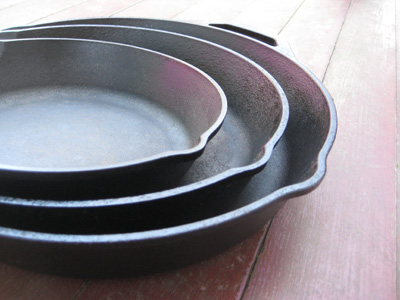
How to season (or cure) a cast iron pan
1. Preheat your oven to 350 degrees.
2. Clean your pan with mild soap and water and then dry thoroughly. Some cast iron pans come with a light coating that will need to be washed off.
3. Place a thin even coating of vegetable oil in the pan. Use something like corn or safflower oil. Traditionally, people used lard. But how many of us have lard sitting around the house these days?
4. Set the pan in your preheated oven and heat for one hour. Lodge recommends placing the pan upside down on a cookie sheet or foil, although I've never done this myself.
5. Turn off the oven and then either let the pan cool down inside or, with an oven mitt, remove the pan and set on the stovetop to cool.
6. Once the pan is cool, wipe it down with a paper towel. Set aside for later use.
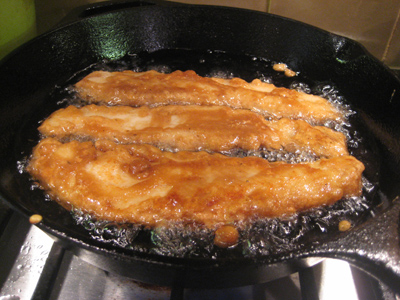
Once a pan is initially seasoned, I like to cook something that requires a lot of oil to make sure it really gets thoroughly lubricated and heated. Fish and chips or fried chicken is a great choice as you need to heat your pan thoroughly with oil for an extended period of time. I also like to cook up a batch of bacon a day or two after curing.
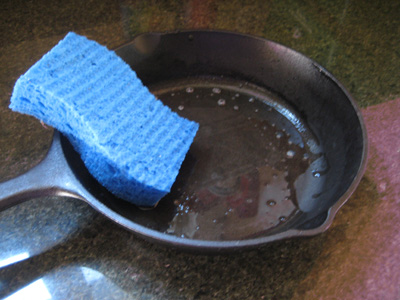
Cleaning and caring for your cast iron pan
Lodge recommends avoiding soap when cleaning your pan and to use a "stiff nylon brush and hot water" instead. I have NEVER taken this advice. For ten years I have cleaned my cast iron pans with mild dishwashing detergent and then scrubbed lightly with a kitchen sponge. In all this time, I've never scoured off the seasoning; then again, I don't use a Brill-o pad, which should be avoided.
My tried and true method for cleaning my pans is to simply add some water to them after cooking my meals and then let them sit while we eat. By the time I'm ready to clean up, everything has loosened up and the pans are easy to clean. Just remember not to let the pans sit with water in them for more than a half hour or they may start to rust. If something really gets stuck in there, I set the pan on the stove, add a bit of water, and heat until the water starts to boil. I then gently scrape the bottom of the pan with a wooden spatula until the remnants release. That's it. And, if for some reason you do need to thoroughly scour your pan, you can always just re-season it again. Never, ever, put it in the dishwasher.
Once your pan is clean, towel it dry thoroughly. If you want to make sure it's completely dry, you can also heat it on the stove for a bit to help evaporate any leftover moisture. Do not let it air dry as it may rust. Store your pans in a cool dry place. I like to keep mine in the oven or even on top of the stove, but any place that avoids moisture is fine.
Where to buy a cast iron pan
So where can you get a cast iron pan? Almost anywhere. From Williams-Sonoma and Sur la Table to Target, Amazon, and your local hardware store, these pans are available pretty much any place selling kitchen equipment.
A few tips to using a cast iron pan
